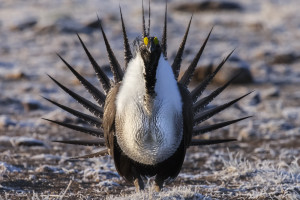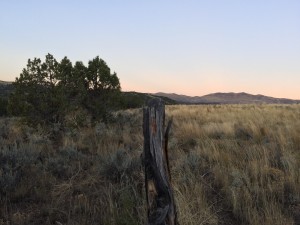Sage grouse populations across the West have been declining drastically over the last 100 years but a conservation effort led by the United States Department of Agriculture — the Sage Grouse Initiative — has provided promising results since its launch in 2010. And, now, USDA and partners involved in the project have a new interactive online map to better target invasive species that are damaging sage grouse habitat and associated rangeland.

Colorado State University’s Michael Falkowski, associate professor in the Department of Ecosystem Science and Sustainability, created the Tree Canopy Cover layer of the map, which shows where conifers are degrading sagebrush — and where predators might be lurking — in Western states.
“Sage grouse were being considered for inclusion on the endangered species list,” Falkowski said. “But thanks to the initiative, private landowners, federal and state agencies are collaborating to protect this species of concern. It creates a win-win situation for everyone.”

Sage grouse are large chicken-like birds with spiky tails. They are charismatic; the males strut and fan their tails during mating season, making them popular with birders and wildlife watchers. The birds are also a canary in the coal mine, a marker for the health of sagebrush, said Dave Naugle, science advisor for the Sage Grouse Initiative and a professor in the Wildlife Biology Program at the University of Montana.
“As the sage grouse goes, so goes ranching in the West,” Naugle said.
The new online map is free and available to the public.
“We often do intriguing science but sometimes it doesn’t get into the hands of experts and others who can help,” Naugle said. “The new web app and map make sure people on the ground have the best science.”
The map is powered by Google Earth Engine and Falkowski’s contribution really makes it unique, Naugle said. “Mike’s tree canopy layer is the first time we’ve had a geospatial view of this threat to sage grouse across 100 million acres,” he explained. “His work is a beautiful marriage between satellite mapping technology and on-the-ground conservation actions.”
Ranchers play key role in conservation efforts
Since 2010, the Sage Grouse Initiative has enrolled more than 1,250 ranchers across the West, making this project an “unprecedented scale of conservation,” according to Naugle.
Jay Tanner, whose family farm is in Utah, is among the private land owners helping with conservation. “What’s good for sage grouse is good for cattle and other wildlife, too,” Tanner said in an interview with Initiative staff.

Falkowski said the canopy cover he created is of great interest to ranchers. “This has given the Sage Grouse Initiative and ranchers a tool to start prioritizing conifer removal in historic sagebrush habitats,” he said.
Pinyon and juniper are native conifer tree species in the West, but they have become more invasive due to “Smokey the Bear” policies, Naugle said. “Sage grouse hate these tree structures and the trees harbor predators,” which is why they are targeted to be removed as part of the Initiative.
Without a mapping tool, ranchers and conservationists don’t know where the trees are or how to effectively allocate financial resources. Now, they can see where conifers have invaded, so that individual projects integrate with others.
“The mapping tool can help folks work on the ground in a much more coordinated fashion,” Naugle said.
What’s next? Falkowski said he and his team are working on landscape modeling. “We’re looking at the spatial relationship between sage grouse breeding areas and other habitats, to see how we should prioritize conifer removal areas to get the most biological return on investment.”
Naugle said the team is in its second year of Sage Grouse Initiative 2.0, a $211 million project with a strategy sketched out through 2018.